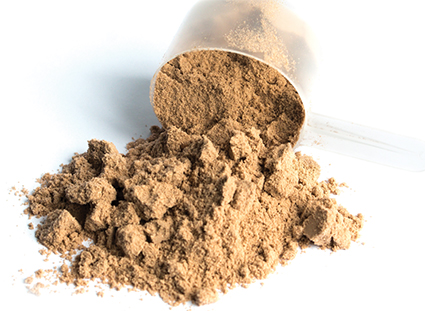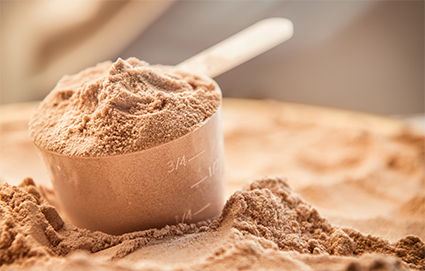Crank Up Your Metabolism With Whey Protein

In the battle of the bulge, whey protein may be the key to preserving muscle mass and losing weight.
Whey protein’s abilities to fight cancer, improve glutathione levels, and boost immunity are well documented. While additional research suggests possible medical uses for whey that unexpectedly differ from whey’s traditional role as an immune booster and anti-cancer functional food, it’s the discovery of whey’s possible effects on weight loss that is the focus of this article.

What Is Whey?
Whey is a complex milk-based ingredient made up of protein, lactose, fat, and minerals. Protein is the best-known component of whey and is made up of many smaller protein subfractions such as beta-lactoglobulin, alpha-lactalbumin, immunoglobulins (IgGs), glycomacropeptides, bovine serum albumin (BSA), and minor peptides such as lactoperoxidases, lysozyme, and lactoferrin. Each subfraction has its own unique biological properties. Modern filtering technology has improved dramatically in the past decade, allowing companies to separate some of the highly bioactive peptides—such as lactoferrin and lactoperoxidase—from whey. Some of these subfractions are only found in very minute amounts in cow’s milk, normally at less than one percent (such as lactoferrin and lactoperoxidase).

 Whey & Hormones
Whey & Hormones
Human hunger and appetite are regulated by a complicated set of overlapping feedback networks, involving a long list of hormones, psychological factors, and physiological factors, all of which are still being interpreted. Researchers are particularly focused on the hormone cholecystokinin (CCK) for possible solutions to obesity. Several decades ago, researchers found CCK largely responsible for the feeling of fullness or satiety experienced after a meal. It partially controls appetite, at least in the short term.
Cholecystokinin (CCK) is a small peptide with multiple functions in both the central nervous system and the periphery (via CCK-B and CCK-A receptors, respectively). Along with other hormones, such as pancreatic glucagon, bombesin, glucagon-like peptide-1 (GLP-1) amide, oxyntomodulin, peptide YY (PYY), and pancreatic polypeptide (PP), CCK is released by ingested food from the gastrointestinal tract and mediates satiety after meals.
Researchers also consider the effects of “master hormones” such as insulin and leptin. The release of these hormones depends on the concentration and composition of the nutrients ingested—that is, the type of nutrients (i.e., fat, protein, and carbohydrates) eaten, the amount of each eaten, and the composition of the meal, all which affect which hormones are released and in what amounts.

Whey & Food Intake
Whey protein may have some unique effects on food intake via its effects on CCK and other pathways. Many studies have shown that protein is the most satiating macronutrient. However, it also appears all proteins may not be created equal. For example, two studies using human volunteers compared the effects of whey versus casein (another milk-based protein) on appetite, CCK, and other hormones.1 The first study found that energy intake from a buffet meal was significantly less 90 minutes after a liquid meal containing whey, compared with an equivalent amount of casein given 90 minutes before the volunteers were allowed to eat all they wanted at the buffet. In the second study, the same whey preload led to a plasma CCK increase of 60 percent (in addition to large increases in GLP-1 and glucose-dependent insulinotropic polypeptide) following the whey preload compared with the casein.
People who took whey before they were allowed to eat all they wanted at a buffet showed a decrease in the amount of calories they ate as well as substantial increases in CCK compared to casein. Subjectively, it was found there was also greater satiety following the whey meal. Researchers concluded, “These results implicate post-absorptive increases in plasma amino acids together with both CCK and GLP-1 as potential mediators of the increased satiety response to whey and emphasize the importance of considering the impact of protein type on the appetite response to a mixed meal.” Several animal studies also find that whey appears to have a pronounced effect on CCK and or satiety over other protein sources.

However, not all studies have found the effect of whey versus other protein sources on food intake.2 Although studies find protein to be the most satiating of the macronutrients, certain protein sources (e.g., egg whites) may actually increase appetite,3 so protein sources appear worth considering when looking to maximize weight loss and suppress appetite. How whey achieves this effect is not fully understood, but research suggests it’s due to whey’s high glycomacropeptide and alpha-lactalbumin content, as well as its high solubility compared to other proteins, and perhaps its high percentage of branched-chain amino acids (BCAAs).
Whey On Bodyfat, Insulin & Fat Burning
 So we have some studies suggesting whey may have some unique effects on hormones involved in satiety and/or may reduce energy (calorie) intake of subsequent meals, but are there studies showing direct effects of whey versus other proteins on weight loss? In animals, at least, whey has looked like a promising supplement for this.
So we have some studies suggesting whey may have some unique effects on hormones involved in satiety and/or may reduce energy (calorie) intake of subsequent meals, but are there studies showing direct effects of whey versus other proteins on weight loss? In animals, at least, whey has looked like a promising supplement for this.
Although higher protein diets have been found to improve insulin sensitivity, and may be superior for weight loss than higher carbohydrate-lower protein diets, it’s unclear if all proteins have the same effects. One study compared whey to beef4 and found whey reduced body weight and tissue lipid levels and increased insulin sensitivity compared to red meat. Rats were fed a high-fat diet for nine weeks and then switched to a diet containing either whey or beef for an additional six weeks. As has generally been found in other studies, the move to a high dietary protein reduced energy intake (due to the known satiating effects of protein compared to carbs or fat), as well as reductions in visceral and subcutaneous body fat.
However, with the rats getting the whey, there was a 40 percent reduction in plasma insulin concentrations and increased insulin sensitivity compared to the red meat. Not surprisingly, the researchers concluded, “These findings support the conclusions that a high-protein diet reduces energy intake and adiposity and that whey protein is more effective than red meat in reducing body weight gain and increasing insulin sensitivity.”

Other studies suggest taking whey before a workout is superior for preserving/gaining lean body mass and maintaining fat burning (beta oxidation) during exercise over other foods taken prior to a workout. The study5 came to some very interesting conclusions. One thing we know is the composition of the pre-exercise meal will affect substrate utilization during exercise and thus might affect long-term changes in body weight and composition. That is, what you eat before you work out can dictate what you use for energy (i.e., carbs, fats, and or proteins), which alters what you burn (oxidize) for energy.
Researchers made groups of rats exercise two hours daily for over five weeks, either in the fasted state or one hour after they ingested a meal enriched with a simple sugar (glucose), whole milk protein or whey protein. The results were telling. Compared with fasting, the glucose meal increased glucose oxidation and decreased lipid oxidation during and after exercise. Translated, the rats burned sugar over body fat for their energy source. In contrast, the whole milk protein and whey meals preserved lipid oxidation and increased protein oxidation, meaning that fat burning was maintained and they also used protein as a fuel source. Not surprisingly, the whey meal increased protein oxidation more than the whole milk protein meal, most likely because whey is a “fast” protein that is absorbed rapidly due to its high solubility.

As one would expect, by the end of the five weeks, body weight was greater in the glucose, whole milk protein and whey-fed rats than in the fasted ones. But here is where it gets interesting. In the group getting the glucose or the whole milk protein, the increase in weight was from body fat, but in the whey-fed group, the increase in weight was from an increase in muscle mass and a decrease in body fat! Only the rats getting the whey before their workout increased muscle mass and decreased their body fat. The researchers theorized this was due to whey’s ability to rapidly deliver amino acids during exercise. Is this the next big find in sports nutrition or anti-aging muscle preservation? It’s hard to say based on studies with rats, but if it turns out to be true in humans, it would indeed be a breakthrough in the quest to add muscle and lose fat.
 Whey Helps You Lose Fat
Whey Helps You Lose Fat
Taken in isolation, none of these studies are so compelling that people should run out and use whey as some form of weight-loss magic bullet. However, taken as a total picture, the bulk of the research seems to conclude that whey may in fact have some unique effects for weight loss. More studies are clearly needed. So what is the practical application of all this information and how do you put it to good use? Given that the appetite-suppressing effects of whey appear to last approximately two to three hours, it would seem best to stagger the intake throughout the day. For example, breakfast might be one to two scoops of whey and a bowl of oatmeal, and perhaps a few scoops of whey taken between lunch and dinner.
References:
1. Hall WL, Millward DJ, Long SJ, Morgan LM. Casein and whey exert different effects on plasma amino acid profiles, gastrointestinal hormone secretion and appetite. Br J Nutr. 2003 Feb;89(2):239-48.
2. Bowen J, Noakes M, Clifton P, Jenkins A, Batterham M.Acute effect of dietary proteins on appetite, energy intake and glycemic response in overweight men. Asia Pac J Clin Nutr. 2004;13(Suppl):S64.
3. Anderson GH, Tecimer SN, Shah D, Zafar TA. Protein source, quantity, and time of consumption determine the effect of proteins on short-term food intake in young men. J Nutr. 2004 Nov;134(11):3011-5.
4. (Damien P. Belobrajdic, Graeme H. McIntosh, and Julie A. Owens. A high-whey-protein diet reduces body weight gain and alters insulin sensitivity relative to red meat in Wistar rats. J. Nutr. 2004 Jun;134:1454-1458.
5. Bouthegourd JC, Roseau SM, Makarios-Lahham L, Leruyet PM, Tomé DG, Even PC. A preexercise lactalbumin-enriched whey protein meal preserves lipid oxidation and decreases adiposity in rats. Am J Physiol Endocrinol Metab. 2002 Sep;283(3):E565-72.
To read more from Will Brink, click HERE!
Click HERE to sign up for our free newsletter!


